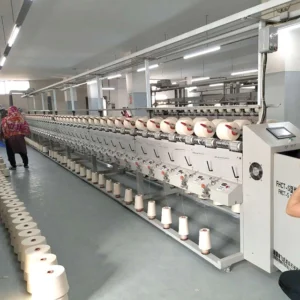The textile industry is highly competitive, and manufacturers are constantly seeking ways to improve efficiency, reduce waste, and enhance product quality.
Lean manufacturing, a methodology focused on minimizing waste while maximizing productivity, offers a proven framework for achieving these goals.
By implementing lean principles, textile factories can streamline operations, reduce costs, and deliver higher value to customers.
This article explores how to apply lean manufacturing principles in textile factories, providing practical insights for businesses looking to optimize their production processes.
From eliminating waste to fostering a culture of continuous improvement, lean manufacturing can transform textile production and drive long-term success.
What Are the Core Principles of Lean Manufacturing?
Eliminating Waste
Lean manufacturing focuses on identifying and eliminating waste in all forms, including overproduction, excess inventory, and unnecessary motion.
In textile factories, waste can manifest as fabric scraps, excess dye, or inefficient workflows.
By reducing waste, factories can operate more efficiently, save resources, and lower production costs.
For example, implementing precise cutting techniques can minimize fabric waste, while optimizing dyeing processes can reduce chemical usage.
Continuous Improvement
Kaizen, or continuous improvement, is a key principle of lean manufacturing. It encourages employees at all levels to identify and implement small, incremental changes that lead to significant improvements over time.
In textile factories, this could involve regularly reviewing production processes to find ways to reduce downtime or improve machine efficiency.
By fostering a culture of Kaizen, factories can achieve sustained growth and adaptability.
Value Stream Mapping
Value stream mapping involves analyzing the entire production process to identify areas where value is added and where waste occurs.
In textile manufacturing, this might include mapping the journey of raw materials from sourcing to finished products.
By visualizing the workflow, factories can pinpoint bottlenecks, redundancies, and inefficiencies, enabling them to optimize processes and improve overall productivity.
How Can Lean Manufacturing Reduce Costs in Textile Factories?
Minimizing Material Waste
By implementing lean practices, textile factories can reduce material waste, such as fabric scraps and excess dye.
For instance, using advanced cutting machines with precision technology can minimize fabric offcuts, while optimizing dye formulations can reduce chemical waste.
This not only lowers costs but also supports sustainability efforts, making the factory more environmentally friendly.
Optimizing Inventory Management
Lean manufacturing emphasizes maintaining just-in-time inventory, which reduces storage costs and minimizes the risk of overstocking or stockouts.
In textile factories, this means ordering raw materials like yarn or dyes only when needed, based on real-time demand.
This approach reduces the financial burden of holding excess inventory and ensures that materials are used efficiently.
Improving Labor Efficiency
Lean principles help streamline workflows, reducing unnecessary movement and downtime. For example, reorganizing workstations to minimize the distance workers need to move between tasks can save time and energy.
This allows employees to focus on value-added tasks, increasing productivity and reducing labor costs.
What Are the Benefits of Lean Manufacturing for Textile Factories?
Enhanced Product Quality
Lean manufacturing places a strong emphasis on error prevention and the continuous improvement of processes.
This focus translates directly into the production of higher-quality products with significantly fewer defects. In textile factories, implementing quality control checkpoints at various stages of production is a common practice.
These checkpoints allow for the early detection of issues, whether it’s flaws in the fabric, inconsistencies in dye application, or problems during the finishing process.
By catching these issues early, factories can prevent defective products from proceeding further down the production line, which not only minimizes waste but also mitigates the costs associated with rework or scrap.
Enhanced product quality goes beyond just reducing defects; it also leads to greater customer satisfaction. Consumers today are more discerning and expect reliable quality in their purchases.
When textile factories produce high-quality goods consistently, they strengthen their brand reputation, build customer loyalty, and ultimately create more demand for their products.
Faster Production Cycles
One of the primary advantages of lean manufacturing is its ability to streamline production processes by eliminating bottlenecks and optimizing workflows.
In the context of textile manufacturing, this can be achieved by synchronizing various processes, such as dyeing and weaving. Often, delays occur when one process is waiting for the other to finish, leading to unnecessary downtime.
By streamlining these workflows—perhaps by leveraging just-in-time production techniques—factories can significantly reduce the waiting times between stages.
This increased efficiency not only enables faster production cycles but also enhances overall responsiveness.
As a result, textile factories can meet customer demands more effectively, reacting swiftly to changes in order volumes or styles.
Additionally, faster production cycles can lead to more efficient use of resources and can help factories maintain better inventory control, reducing the costs associated with holding excess inventory.
Over time, this agility in production can become a vital competitive advantage in the fast-paced textile market.
Increased Customer Satisfaction
The combination of improved product quality and faster production cycles ultimately contributes to increased customer satisfaction.
When customers receive high-quality textiles within a promised timeframe, their expectations are met or exceeded, fostering a stronger relationship between the factory and its clients.
Furthermore, the efficiency gains from lean manufacturing often lead to cost savings, which can either enhance profit margins for the factory or result in more competitive pricing for customers.
Satisfied customers are inclined to return for future purchases and are more likely to recommend the factory to others, resulting in word-of-mouth marketing that is invaluable to business growth.
In today’s interconnected marketplace, where online reviews and social media can significantly impact a brand’s reputation, maintaining high customer satisfaction is crucial.
Moreover, lean manufacturing encourages regular feedback from clients, which helps factories to align their offerings with customer preferences and make adjustments accordingly.
This continuous loop of improvement not only solidifies customer loyalty but also drives the long-term success of textile factories in a competitive landscape.
How to Identify and Eliminate Waste in Textile Production?
Overproduction
Overproduction is one of the most common forms of waste in textile factories. Implementing demand-driven production schedules can help reduce excess inventory and storage costs.
For example, using real-time sales data to plan production can ensure that factories produce only what is needed, when it is needed.
Defects and Rework
Defects in textiles, such as uneven dyeing or stitching errors, lead to rework and waste.
Lean manufacturing focuses on error prevention through quality control measures and employee training.
For instance, regular maintenance of dyeing machines can prevent color inconsistencies, while training workers on proper stitching techniques can reduce errors.
Unnecessary Motion
Inefficient layouts and workflows can result in unnecessary movement of materials and workers.
Streamlining processes and reorganizing workspaces can minimize this waste. For example, placing frequently used tools and materials within easy reach can save time and reduce physical strain on workers.
How to Foster a Culture of Continuous Improvement?
Employee Training and Engagement
Training employees on lean principles and encouraging their active participation in improvement initiatives are essential for fostering a culture of continuous improvement.
For example, workshops on Kaizen can empower workers to identify and solve problems in their daily tasks.
Regular Feedback and Communication
Establishing regular feedback loops and open communication channels allows employees to share ideas and identify areas for improvement.
For instance, holding monthly team meetings to discuss workflow challenges can lead to innovative solutions and stronger collaboration.
Celebrating Successes
Recognizing and celebrating small wins motivates employees and reinforces the importance of continuous improvement.
For example, acknowledging a team that successfully reduced fabric waste can inspire others to contribute to lean initiatives.
What Tools and Techniques Are Used in Lean Manufacturing?
5S Methodology
The 5S methodology (Sort, Set in Order, Shine, Standardize, Sustain) helps organize workspaces, improve efficiency, and maintain cleanliness.
In textile factories, this could involve organizing tools and materials in designated areas to reduce search time and clutter.
Kanban Systems
Kanban is a visual scheduling system that helps manage workflow and inventory levels, ensuring that materials are available when needed.
For example, using Kanban cards to signal when dye supplies are low can prevent production delays.
Poka-Yoke (Error Proofing)
Poka-Yoke involves designing processes to prevent errors before they occur, reducing defects and improving product quality.
In textile factories, this could include using sensors to detect fabric misalignment during cutting, preventing costly mistakes.
How to Measure the Success of Lean Manufacturing Initiatives?
Key Performance Indicators
Track KPIs such as production cycle time, defect rates, and inventory turnover to measure the effectiveness of lean initiatives.
For example, a reduction in defect rates after implementing quality control measures indicates successful lean practices.
Employee Feedback
Gather feedback from employees to identify areas for improvement and ensure that lean practices are being implemented effectively.
Surveys or suggestion boxes can provide valuable insights into workflow challenges and potential solutions.
Customer Satisfaction Metrics
Monitor customer satisfaction through surveys and reviews to assess the impact of lean manufacturing on product quality and delivery times. Positive feedback and repeat orders are strong indicators of success.
Conclusion
Implementing lean manufacturing principles in textile factories offers numerous benefits, including reduced waste, lower costs, and improved product quality.
By focusing on eliminating waste, fostering a culture of continuous improvement, and using proven tools and techniques, manufacturers can optimize their operations and stay competitive in a rapidly evolving industry.
While challenges such as resistance to change and initial investments may arise, the long-term advantages of lean manufacturing make it a worthwhile endeavor.
By embracing lean principles, textile factories can achieve greater efficiency, sustainability, and customer satisfaction, paving the way for a more successful future.












